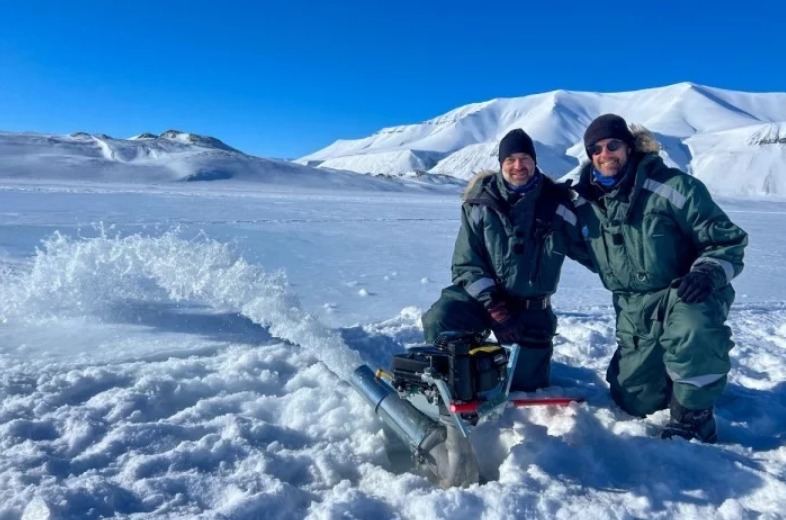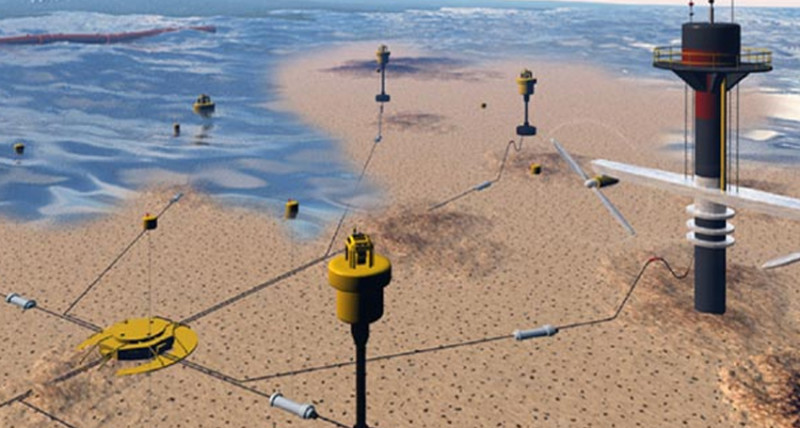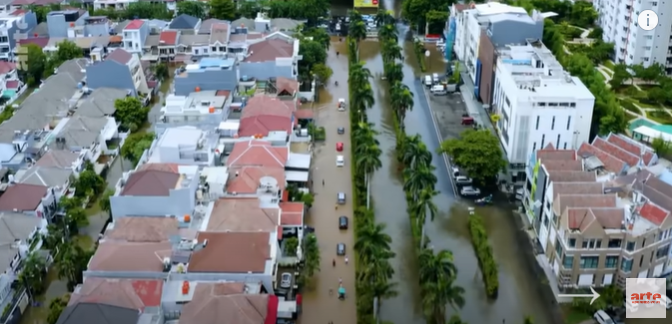Pump sea water then release it onto the ice floe to slow its disappearance? This is the project of the Dutch company Arctic Reflections. A bad idea, judges glaciologist Heïdi Sevestre.
Sunglasses placed on a nose protected by a hood covering his entire face, Tim Hammer holds a long saw in his gloved hand. Sitting between four large aluminum transport boxes which serve as both a table and a stool, the scientist is preparing to cut the ice core that his colleagues have just delivered to him.
The icy cylinder taken from the frozen ocean on which the small temporary laboratory is installed, at the bottom of the Van Mijen Fjord, is one meter long. Wrapped in his big green suit, two hours by snowmobile south of Longyearbyen, the capital of Svalbard, Tim Hammer does not seem bothered by the temperature: – 25°C. “We will be able to study the salinity in the different layers of sea ice: the one that was already there and the one that we have just created. We will know where the salt goes and if it affects the speed at which the ice floe melts,” he explains, his voice muffled by his hood.
This postdoctoral scientist at the University of Delft is collaborating with a young start-up, founded in 2023, which has a great ambition: “Restore the Arctic sea ice in order to counter global warming. » This, in fact, acts as a climate regulator. To do this, the company relies on the technique that makes it possible to create ice rinks: a thin layer of water that freezes quickly. “I told myself that we could thicken the ice floe by sending water over it, thus creating a new layer of ice. In winter, the temperatures are so low that the water [even salty] freezes immediately,” says Dutch entrepreneur Fonger Ypma, who created the start-up Arctic Reflections with his partner Tom Meijeraan.
Giant ice rinks to save the ice floe? French glaciologist Heïdi Sevestre remains skeptical: given the scale of ocean warming, this type of project could divert our attention from the main problem. “Geoengineering][a type of deliberate climate manipulation][is a distraction that makes us believe that we will not have to question our economic system,” she says.
She remains, of course, in agreement on the observation: the sea ice, formed by sea water which freezes naturally in winter, is essential for the climatic balance of the planet. By covering itself with ice at the poles, the ocean acts like an immense mirror whose white surface reflects the sun’s rays, thus regulating global temperature. But due to climate change, the sea ice in the Arctic is less and less extensive in winter, less thick and disappears more quickly in spring. The ocean, dark blue, is much less reflective than snow, and its albedo effect much less powerful.
But there is urgency: this area around the North Pole is warming four times faster than the rest of the globe. As of September 2023, the minimum extent of Arctic sea ice is approximately 4.33 million square kilometers. In the 1980s, it covered 10 million km² at the same time. Since then, each decade, we have lost a little more than 12% of its surface area. “We hear a lot about the melting of glaciers and the consequence of rising water levels. We know less about the importance of the Arctic sea ice and how vulnerable it is,” summarizes Fonger Ypma.
Full-scale test in Svalbard
“Research had been done on the subject, the technology already exists. Why not try to replicate this? “, he enthuses. The technology mentioned by the Dutch forty-year-old is that used for the manufacture of “ice roads”. These ice roads are created artificially by humans, particularly in Canada: they allow convoys of trucks to transport goods to certain isolated communities in the Far North. After removing the snow, water is pumped from under the ice and sprayed onto the thickening surface. Vehicles weighing several tonnes then circulate. Concretely, in Svalbard, it involves using a drill to drill the 80 centimeters of frozen sea, pushing a funnel of around twenty centimeters into the hole and, using a motor no larger than that of a lawnmower, to project water onto the surface of the ice floe.
To support his intuition, Fonger Ypma called on engineer Hayo Hendrikse, assistant professor at the Delft University of Technology, in the Netherlands. After a modeling phase in the laboratory, the team flew to Svalbard for field work in real conditions. “It remains very difficult to imitate reality on a computer. The proof: in five days here, we had ten different weather conditions! » said Hayo Hendrikse, smiling.
The site was not chosen by chance. Despite its geographical position at 78° north latitude, Svalbard is the most easily accessible place in the Arctic. An airport, a town of 2,600 inhabitants and a renowned university center, Unis (The University Center in Svalbard), which supports the experience with its expertise and logistical means. In the middle of April, the sun is already shining almost 24 hours a day, facilitating the work of these polar Shadoks, funny birds that pump tirelessly, like the characters in the animated series from the 1970s .
An unrealistic technique?
“We are trying to prove if we can really thicken the ice. If so, will it survive longer? How much energy do we put into it and what benefits do we get from it? » asks Fonger Ypma, whose young company is financed by wealthy donors and government funds.
Glaciologist Heïdi Sevestre, resident of Longyearbyen, made the trip to interact with the scientists and observe their work. “This full-scale test is of course a minimum. We are all very eco-anxious and we would like to believe that solutions exist but, in my opinion, this technique is hardly realistic. We really need to think about the meaning of what we do and where we put our energy, time and money. » Particularly because it does not solve the basic problem: the temperature of the ocean which is rising. And above all, the ice floe is twenty-five times the size of France!
“What are the consequences if we deploy 10,000 pumps on the ice floe? »
In addition, “the Arctic frigid ocean is still very poorly known and little studied. It is an extremely sensitive environment. We know, for example, that narwhals can pick up sounds more than 40 kilometers away. What could be the consequences if we deploy 1,000 or 10,000 pumps on the ice floe? » asks the scientist. As for noise, the team has nothing planned, but they will send some of their ice cores to the University of Svalbard so that living organisms, such as algae that live in and under the ice floe, can be studied there. .
Hayo Hendrikse wants to be reassuring, and assures that it is in no way a question of geoengineering. “We do not add any other material to what is already present on site, no chemicals. It’s just salt water that we’re moving around. As it melts, the ice will turn back into salt water and that’s it. » What about the back and forth of the snowmobile that transports the ice cores from the pumping sites to the “lab cabin” and the gasoline used to operate the pumps? If the project expands, these will be replaced by larger models operating with “green” energies, assures the team.
The engineers will have the results of their experiment after the summer, when the fjord’s ice floe has completely melted and the sensors left on the ice have been recovered. If the experiment proves conclusive, could this technology be deployed in time? Some scientists estimate that the Arctic could be deprived of sea ice as early as the 2030s, a decade earlier than the latest IPCC projections. Fonger Ypma recognizes it, they will still need at least five years to be ready, “but not later, otherwise it will be too late” and adds “now that we have had the idea, it would be sad not to to try « .




